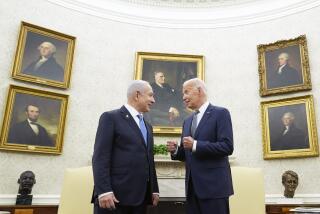Cellphone alarms were set to trigger Yemen package bombs, U.S. officials say
- Share via
Reporting from Washington — Two package bombs sent from Yemen were probably designed to be triggered by an alarm set on a cellphone attached to a syringe filled with chemical material to detonate the explosives, two U.S. officials said Thursday.
Militants are believed to have tested the length of time it took a package to travel from Yemen to Chicago during a dry-run shipment of books and compact discs in September, and probably set the cellphone alarms to go off while the aircraft were in the air, authorities previously said.
John Brennan, President Obama’s top counterterrorism advisor, had said Sunday that the bombs were designed to be “self-contained” and did not require someone to press a syringe.
On Thursday, two U.S. officials confirmed that a syringe in the bomb was intended to act as a blasting cap initiated by a cellphone alarm. The officials spoke on condition of anonymity because they were not authorized to disclose information about an ongoing investigation.
When the alarm went off, electrical current from the phone battery would have run through a thin wire filament, similar to those in lightbulbs, that would have ignited a small amount of combustible liquid and detonated the bomb.
Once the bomb makers had the parts, the devices would not have been difficult to assemble, said Dave Williams, a retired FBI explosives expert who investigated the 1993 World Trade Center bombing.
“If you could make brownies from a Duncan Hines box mix, you could make this device,” Williams said Thursday.
Meanwhile, U.S. officials were skeptical of claims by a French government minister that one of the bombs was disarmed minutes before it was set to explode.
Interior Minister Brice Hortefeux told France 2 television Thursday that “one of these packages was defused just 17 minutes before the planned explosion time.” White House Press Secretary Robert Gibbs said he had “no information that would confirm that,” but he did not entirely dismiss the claims.
An official at the Yemeni Embassy in Washington said his government also was not aware that the bombs were defused with 17 minutes to spare.
“I love this French minister,” said the Yemeni official, who spoke on condition of anonymity because of the sensitivity of the matter. “He talks a lot.”
The bombs were discovered on planes last Friday and defused, one in Dubai, in the United Arab Emirates, and the other in East Midlands, England. Both packages were addressed to Jewish organizations in Chicago, though officials believe they were intended to be detonated before arrival.
Yemeni commando units have been sent to the Marib province in central Yemen to capture the bomb maker, the Yemeni official said.
Investigators believe the devices are the work of Ibrahim Hassan Asiri, a Saudi member of Al Qaeda in Yemen, who designed the bomb used on a Detroit-bound airliner on Christmas Day. That bomb, which failed to detonate, involved PETN, the same explosive found in the Yemen packages. It also included a syringe full of a chemical liquid that was designed to be plunged by hand into the PETN to set off an explosion.
The bombs bear the hallmarks of two generations of Al Qaeda explosives designers, said Williams, whose forensic work contributed to the 1997 conviction of bomb maker Ramzi Ahmed Yousef, nephew of self-proclaimed Sept. 11 mastermind Khalid Shaikh Mohammed. Yousef trained many of the Al Qaeda bomb makers working today, Williams said.
Chris Ronay, who headed the FBI forensic investigation into the 1988 bombing of Pan Am Flight 103 over Lockerbie, Scotland, said the basic outlines of the Yemen plot — putting into the international transit system a disguised time bomb set to explode days later — are not that different from the Lockerbie plot.
It also mirrors one of the first bombings by the Unabomber, Theodore Kaczynski, who mailed a bomb wired to a barometer that went off inside the cargo hold of an airplane in 1978.
Twenty years ago, it was difficult to build a timer that could be set for days ahead. The Libyan bombers who planned the 1988 Lockerbie attack, which involved checking a suitcase in Malta bound for the U.S., had to have a special timer designed in Switzerland, Ronay said.
Today, the cellphones people carry around in their pockets are “much more sophisticated timers,” Ronay said.
Before it was uncovered, the explosive device found in Dubai had flown on two passenger airliners, first from Sana, the Yemeni capital, to Doha, Qatar, and then from Doha to Dubai.
Times staff writer Ken Dilanian in New Orleans contributed to this report.
More to Read
Sign up for Essential California
The most important California stories and recommendations in your inbox every morning.
You may occasionally receive promotional content from the Los Angeles Times.















